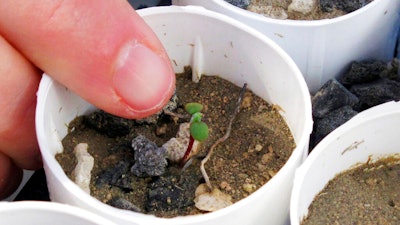
RENO, Nev. (AP) — Few people had ever heard of Tiehm’s buckwheat when conservationists filed a petition two years ago to list the desert wildflower as an endangered species.
But federal documents reviewed by The Associated Press show the rare plant at the center of a fight over a proposed lithium mine in Nevada has been on the government’s radar for more than two decades.
Conservationists who discovered the records are urging the Bureau of Land Management to take administrative action to create a mile-buffer around the flower while the U.S. Fish and Wildlife Service considers formal protection under the Endangered Species Act.
“BLM recognized that the habitat of Tiehm’s buckwheat needed to be protected 23 years ago,” said Naomi Fraga, the California Botanic Garden conservation director who filed the original federal listing petition in 2019.
The scientist the plant is named after — Arnold Tiehm, pronounced like a sports "team” — first suggested in 1994 the site be declared a special botanical area and made off-limits to mining.
A year later, the supervisory botanist for the Nevada agency now considering state protection for the plant recommended the Bureau of Land Management designate it an Area of Critical Environmental Concern. And in 1998, the bureau listed it among those nominated for such designation.
Today, the Nevada site remains the only place on earth the plant is known to exist. The Center for Biological Diversity says Australia-based Ioneer's proposed lithium mine about 200 miles (320 kilometers) northwest of Las Vegas would destroy it.
“Management under BLM’s default `multiple-use policy' has utterly failed to adequately protect Tiehm’s buckwheat or its habitat,” the center said in its March 29 petition seeking the designation. “Tiehm’s buckwheat is staring down the barrel of extinction."
USFWS initiated a formal 12-month review of the plant last July with a listing decision due this summer.
The flower was discovered at Rhyolite Ridge in the Silver Peak Range in 1983 and named a new species in 1985.
Arnold Tiehm's 1994 report for Nevada's Natural Heritage Program said 17,000 plants located were limited to five sites, noting all five were “open to mineral entry and exploration which may modify or destroy habitat in the future.” He recommended “BLM remove the sites from multiple-use status, or at least from mineral entry.”
James Moreland, now supervisory botanist for Nevada's Division of Natural Heritage, said in a 1995 report for USFWS that “based on current knowledge (it) meets the definition of a threatened species under the Endangered Species Act.”
“Aggressive measures are needed to prevent its extinction, including frequent monitoring, pursuit by BLM of ACEC designation with minerals withdrawals, and ... listing as threatened if necessary to prevent further declines,” he wrote.
Rhyolite Ridge was among seven Areas of Critical Environmental Concern the bureau proposed in its 1994 draft environmental impact statement for the Tonopah district's Resource Management Plan.
Documents indicate the agency dropped all seven from its final decision in 1997 due to opposition from local counties, but listed it again in a 1998 Federal Register notice seeking additional nominations.
Patrick Donnelly, the center's Nevada director, found it on the notice's brief description of 43 locations already nominated, including volcanic lava flows, petroglyphs, ghost towns, Joshua trees and, at Rhyolite Ridge, an "uncommon plant.”
“We’d been kicking around the idea of proposing ACEC designation for the Tiehm’s buckwheat habitat for awhile, but finding this ancient evidence of neglect by BLM was all the impetus we needed to move forward,” Donnelly said.
Bureau spokesman Jess Harvey said Thursday the agency would consider such a proposal the next time it develops amendments to the district resource management plan, but none currently is planned.
Ioneer declined comment but said it expects final approval of the mine before the end of the year.
Last month, it completed an $80 million stock sale to public investors in a capital-raising effort led by Goldman Sachs that Ioneer's managing director Bernard Rowe said will allow it to accelerate development of the mine.
“Rhyolite Ridge remains the most advanced and highest quality lithium project in the US, and with these additional funds we look forward to rapidly closing out a number of key value-adding milestones over the course of 2021 as we move quickly towards production and becoming a major part in the US lithium supply chain,” Rowe said.






















